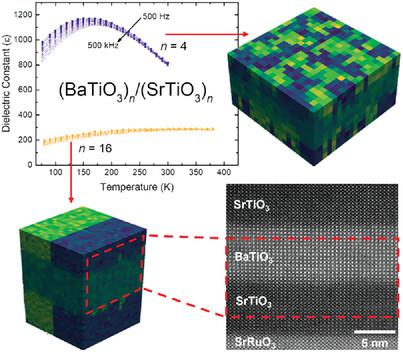当前位置:
X-MOL 学术
›
Adv. Mater.
›
论文详情
Our official English website, www.x-mol.net, welcomes your
feedback! (Note: you will need to create a separate account there.)
Engineering Relaxor Behavior in (BaTiO3)n/(SrTiO3)n Superlattices
Advanced Materials ( IF 27.4 ) Pub Date : 2023-07-11 , DOI: 10.1002/adma.202302012 Eduardo Lupi 1, 2 , Robert B Wexler 3, 4 , Derek Meyers 1, 5 , Anton Zahradnik 1 , Yizhe Jiang 1 , Sandhya Susarla 2 , Ramamoorthy Ramesh 1, 2 , Lane W Martin 1, 2 , Andrew M Rappe 3
Advanced Materials ( IF 27.4 ) Pub Date : 2023-07-11 , DOI: 10.1002/adma.202302012 Eduardo Lupi 1, 2 , Robert B Wexler 3, 4 , Derek Meyers 1, 5 , Anton Zahradnik 1 , Yizhe Jiang 1 , Sandhya Susarla 2 , Ramamoorthy Ramesh 1, 2 , Lane W Martin 1, 2 , Andrew M Rappe 3
Affiliation

|
Complex-oxide superlattices provide a pathway to numerous emergent phenomena because of the juxtaposition of disparate properties and the strong interfacial interactions in these unit-cell-precise structures. This is particularly true in superlattices of ferroelectric and dielectric materials, wherein new forms of ferroelectricity, exotic dipolar textures, and distinctive domain structures can be produced. Here, relaxor-like behavior, typically associated with the chemical inhomogeneity and complexity of solid solutions, is observed in (BaTiO3)n/(SrTiO3)n (n = 4–20 unit cells) superlattices. Dielectric studies and subsequent Vogel–Fulcher analysis show significant frequency dispersion of the dielectric maximum across a range of periodicities, with enhanced dielectric constant and more robust relaxor behavior for smaller period n. Bond-valence molecular-dynamics simulations predict the relaxor-like behavior observed experimentally, and interpretations of the polar patterns via 2D discrete-wavelet transforms in shorter-period superlattices suggest that the relaxor behavior arises from shape variations of the dipolar configurations, in contrast to frozen antipolar stripe domains in longer-period superlattices (n = 16). Moreover, the size and shape of the dipolar configurations are tuned by superlattice periodicity, thus providing a definitive design strategy to use superlattice layering to create relaxor-like behavior which may expand the ability to control desired properties in these complex systems.
中文翻译:

(BaTiO3)n/(SrTiO3)n 超晶格中的工程弛豫行为
由于这些晶胞精确结构中不同性质的并置和强界面相互作用,复合氧化物超晶格为许多涌现现象提供了途径。这在铁电和介电材料的超晶格中尤其如此,其中可以产生新形式的铁电性、奇异的偶极织构和独特的畴结构。在这里,在 (BaTiO 3 ) n /(SrTiO 3 ) n ( n = 4–20 晶胞) 超晶格中观察到类似弛豫行为,通常与固溶体的化学不均匀性和复杂性相关。介电研究和随后的 Vogel-Fulcher 分析表明,介电最大值在一定周期范围内具有显着的频率分散,并且介电常数增强,并且对于较小的周期n具有更鲁棒的弛豫行为。键价分子动力学模拟预测了实验中观察到的类弛豫行为,并且通过短周期超晶格中的二维离散小波变换对极性模式的解释表明,弛豫行为是由偶极构型的形状变化引起的,与较长周期超晶格中冻结的反极条纹域( n = 16)。此外,偶极结构的尺寸和形状通过超晶格周期性进行调整,从而提供了一种明确的设计策略,以使用超晶格分层来创建类似弛豫的行为,这可能会扩展控制这些复杂系统中所需属性的能力。
更新日期:2023-07-11
中文翻译:

(BaTiO3)n/(SrTiO3)n 超晶格中的工程弛豫行为
由于这些晶胞精确结构中不同性质的并置和强界面相互作用,复合氧化物超晶格为许多涌现现象提供了途径。这在铁电和介电材料的超晶格中尤其如此,其中可以产生新形式的铁电性、奇异的偶极织构和独特的畴结构。在这里,在 (BaTiO 3 ) n /(SrTiO 3 ) n ( n = 4–20 晶胞) 超晶格中观察到类似弛豫行为,通常与固溶体的化学不均匀性和复杂性相关。介电研究和随后的 Vogel-Fulcher 分析表明,介电最大值在一定周期范围内具有显着的频率分散,并且介电常数增强,并且对于较小的周期n具有更鲁棒的弛豫行为。键价分子动力学模拟预测了实验中观察到的类弛豫行为,并且通过短周期超晶格中的二维离散小波变换对极性模式的解释表明,弛豫行为是由偶极构型的形状变化引起的,与较长周期超晶格中冻结的反极条纹域( n = 16)。此外,偶极结构的尺寸和形状通过超晶格周期性进行调整,从而提供了一种明确的设计策略,以使用超晶格分层来创建类似弛豫的行为,这可能会扩展控制这些复杂系统中所需属性的能力。

































 京公网安备 11010802027423号
京公网安备 11010802027423号